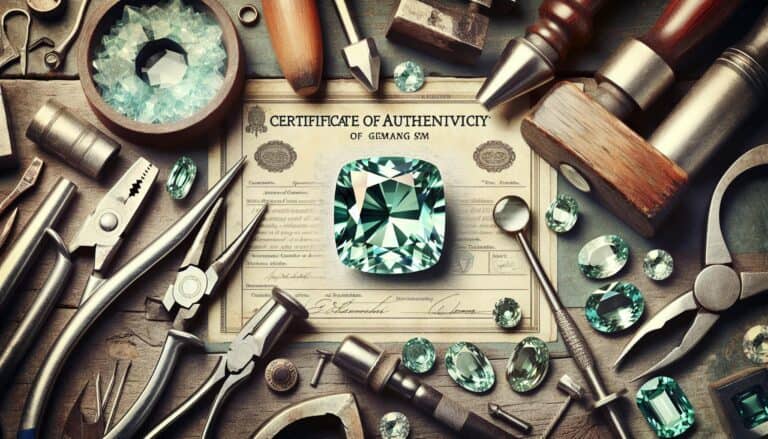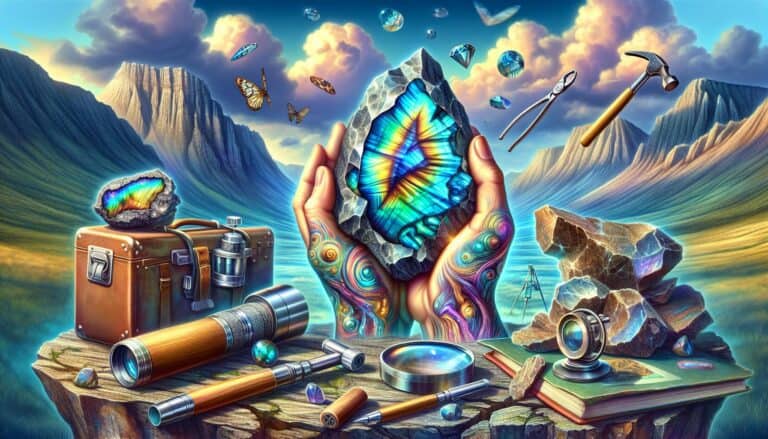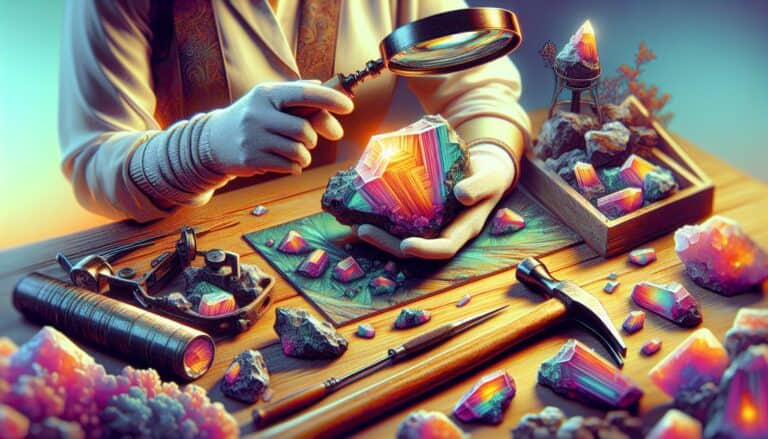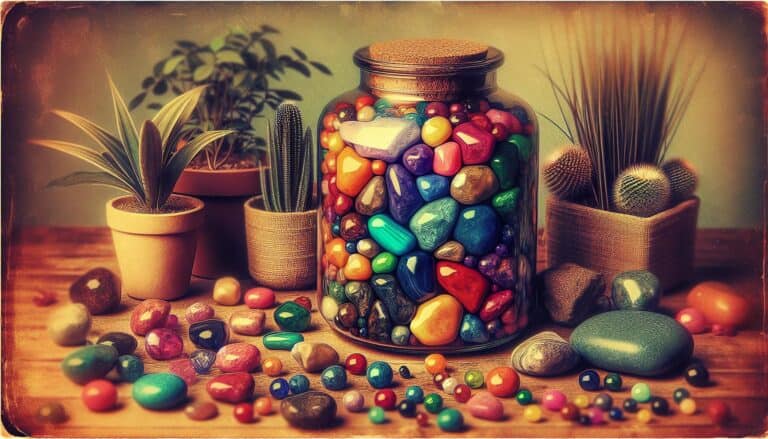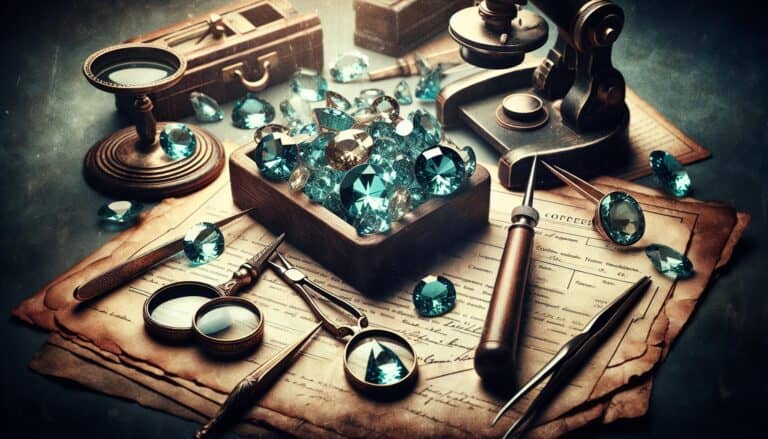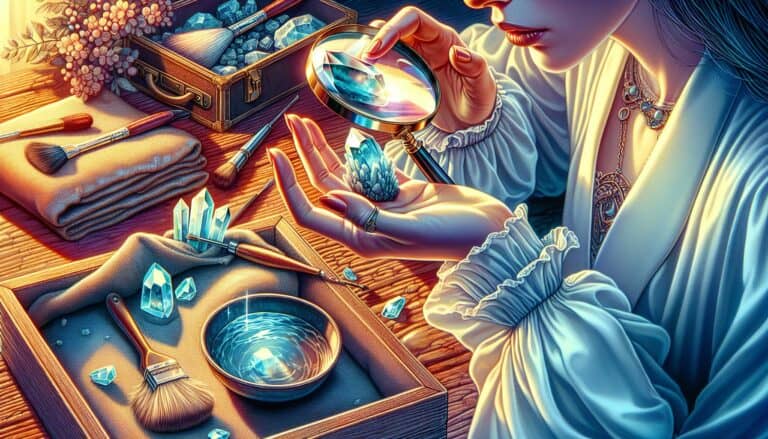Ever wondered about the value of that sleek, mysterious onyx stone in your jewelry collection?
Onyx, with its deep and alluring hues, has been a gemstone of choice for centuries, but its worth isn’t solely based on aesthetics.
Determining the value of onyx can be a complex affair, as it’s influenced by various factors including color, size, and quality. Whether you’re a collector, a jeweler, or simply curious, understanding onyx’s value is key to appreciating its place in the gemstone market.
Stay tuned as we delve into the intricacies of onyx valuation, ensuring you’re equipped with the knowledge to assess the true worth of your onyx pieces.
Onyx value is determined by color, clarity, and cut quality. Black onyx is most valued, especially when deeply colored and well-defined. Market demand and rarity also impact its worth. When buying, seek reputable sellers and verify authenticity with gemological certificates.
What Is Onyx?
Onyx is a banded variety of the oxide mineral chalcedony. It’s comprised of fine intergrowths of silica minerals, quartz, and moganite. These parallel bands distinguish it from other forms of chalcedony, giving it a unique striped appearance.
Traditionally, onyx refers to a black, white, or black-and-white banded gemstone. However, the term is also used to describe any bunted chalcedony with straight, parallel banding. You’ll come across different types of onyx in the market, including those dyed for enhanced color and appearance.
Compared to other gemstones, onyx has a relatively low hardness on the Mohs scale—typically ranging between 6.5 and 7. This factor makes it suitable for carving and jewelry that doesn’t endure heavy wear and tear. You’ll often find onyx used in cameos, beads, and cabochons.
The historical significance of onyx can’t be overstated. It’s been used for centuries, dating back to ancient Greece and Egypt. Many cultures have attributed to onyx protective qualities and believed it could ward off evil. This cultural heritage adds to the allure of onyx as a gemstone with a meaningful past.
In the context of the gemstone market, onyx may not capture the same high value as diamonds or sapphires, but its distinctive look and historical significance sustain its popularity. Whether you’re considering onyx for its aesthetic appeal or its cultural connotations, being informed about what onyx is can aid in making a discerning purchase. Remember, factors like authenticity, cut, and treatment play a significant role in the value of an onyx piece.
Onyx Prices: Factors That Affect Value

When considering the value of onyx, you’ll find several factors come into play. Much like assessing precious diamonds or vibrant gemstones, the characteristics of onyx influence its worth. To navigate the market, you should be aware of how these aspects affect pricing.
Color, Clarity, and Cut Quality
Onyx is coveted for its smooth, distinct bands that create stark contrasts, particularly in black and white varieties. The intensity of the color and how well the bands are defined play significant roles in its value.
- Color: A rich, deep black onyx is often more desirable and thus, more valuable. Vividly colored onyx stones, whether naturally occurring or enhanced through dyeing, can fetch higher prices.
- Clarity: Onyx with clear, unmarred bands increases its allure and value. Stones with cloudy or uneven banding are typically of lower value.
- Cut Quality: Skilled artisans can enhance onyx beauty and worth. A well-executed cut can maximize the stone’s visual appeal, showcasing the banding and color contrast effectively.
Remember, when it comes to carved onyx or pieces that include intricate details, craftsmanship can outweigh pure material value. Onyx is relatively easy to carve, so high-quality workmanship is a critical aspect of assessing its value.
Market Demand and Availability
The market’s interest in onyx at any given time affects its price point. Trends can influence demand, with certain colors or patterns becoming popular. Yet, despite the ebb and flow of trends, traditional black onyx remains in steady demand due to its classic allure.
- Market Demand: High demand for unique or skillfully crafted onyx pieces can drive prices up, even if the stone itself isn’t rare.
- Availability: Although onyx is not as scarce as some gemstones, certain types or colors might be less common. Limited availability of desirable onyx increases its market value.
It’s also worth noting trade factors. Onyx is exported and imported across borders, which can affect its final cost. Variables such as taxation, shipping, and the country of origin can add to the price you’re willing to pay for quality onyx.
Keep in mind, the worth of onyx isn’t solely dictated by its physical properties or market fluctuation. Its historical significance and the narrative attached to specific pieces often amplify their perceived value, making onyx not just a gemstone, but a storyteller’s artifact.
Understanding Onyx: A Rare Gem

As you explore the intrigue of onyx, it’s essential to comprehend its rarity and the unique traits that make this gemstone standout. The following subheadings dive into the specifics of onyx’s scarcity and its origins.
The Rarity of Onyx
Onyx is a chalcedony, a type of quartz with a fine texture, typically found in black or banded varieties. Its distinct and mesmerizing appearance does not occur as copiously as other quartz varieties, which contributes to its exclusivity in the gem market. Several factors contribute to the rarity of onyx:
- Unique Formation: Onyx forms from bands of chalcedony in alternating colors. It’s the preciseness of these bands and the uniformity of color that are less commonly found in nature.
- Desired Varieties: Black onyx, especially with consistent color and no blemishes, is highly sought-after and considered more valuable.
- Limited Sources: There are relatively few onyx quarries compared to other gemstones, constraining supply.
Onyx’s rarity does not only stem from its exceptional presence but also from the demand for quality stones in jewelry and carvings, which often require larger and unblemished specimens.
Origins and Characteristics
The origins of onyx trace back millions of years, forming under specific geological conditions that are not widespread. You’ll find onyx deposits in various parts of the world, such as Brazil, Uruguay, Pakistan, and India, each offering stones with unique hues and patterns. Key aspects of onyx consist of:
- Color Range: Although black is the most famous color, onyx can appear in white, red, brown, and green variations.
- Hardness: Onyx has a Mohs hardness rating of 7, making it durable in wear. However, it requires care to prevent scratches.
- Translucency: Depending on the stone’s thickness, onyx can exhibit a certain level of translucency, adding to its allure.
By acknowledging the geographical roots and distinguishing characteristics of onyx, you can appreciate why this gem carries its esteemed status. Each piece of onyx holds a story that encapsulates ancient history, geological uniqueness, and the meticulous journey from rough stone to polished gem.
Onyx Grading and Valuation
The Grading System for Onyx
When you’re looking into the value of onyx, understanding the grading system is crucial. Like diamonds, onyx gemstones are assessed based on several factors, but with a grading system that’s tailored to the unique qualities of colored stones. Color, pattern, and finish are primary considerations. A deep, consistent black color without blemishes or banding is often deemed the highest quality. However, stones with distinctive and appealing band patterns may be equally sought after depending on current trends and preferences.
Experts also evaluate the surface quality or finish of onyx. A smooth polished surface free of pits and scratches will enhance the gemstone’s allure and thus its market value. It’s also vital to evaluate the stone’s shape and proportions, as a well-executed cut can maximize the onyx’s visual impact. Certifications by reputable sources can attest to the gemstone’s grade, ensuring you get what you pay for.
Certification and Appraisal
Investing in certification and appraisal from accredited labs and gemologists can significantly influence the value of your onyx. Certification provides a third-party assessment of the stone’s quality, ensuring that it meets certain standards of cut, color, clarity, and carat weight. Renowned organizations like the Gemological Institute of America (GIA) or the American Gem Society (AGS) can provide such services, which in turn can give you peace of mind regarding your onyx’s authenticity and quality.
Appraisal, on the other hand, puts a monetary value on your stone, reflecting its current market worth. This is particularly important for insurance purposes or resale. An appraisal typically includes an in-depth look at the gemstone’s physical properties, as well as market research to understand its place within the gem market. Always ensure that the appraiser you choose is unbiased and has recognized credentials in gemology.
Maintaining documentation of your onyx’s grading, certification, and appraisal can be essential if you ever decide to sell the gemstone or pass it down as an heirloom. With proper certification and appraisal, you’ll not only build a stronger understanding of your onyx’s value but also solidify your investment for the long term.
Current Market Trends in Onyx Pricing
Understanding the current market trends in onyx pricing is critical for both collectors and investors. The gemstone market is dynamic, and prices fluctuate based on an array of external factors.
Firstly, onyx is not just treasured for its aesthetic appeal but also its perceived healing properties. As alternative health trends gain traction, the demand for onyx may see an upswing, potentially driving up its price. You’ll notice an increased interest in black onyx jewelry, which is popular for its sleek, modern look and its believed ability to offer protection and strength.
Fashion trends also play a significant role in onyx pricing. When celebrities and influencers adorn onyx in public appearances, the spike in visibility can immediately affect demand. Keep an eye on the fashion industry, as the incorporation of onyx in seasonal collections can hint at upcoming pricing trends.
In terms of geographic influence, specific regions may value onyx higher due to cultural reasons. For example, countries in Asia often have a strong market for onyx, with the stone featuring prominently in local traditions and jewelry designs.
Additionally, technological advancements in gemstone treatments have made it possible to enhance the appearance of onyx, impacting its market appeal and value. These treatments can improve color consistency and clarity, making the stones more enticing to buyers who prioritize aesthetic perfection.
Moreover, it’s important to track the stability of onyx supply chains. Political and economic stability in mining regions directly affects the availability and cost of sourcing the gemstone, which in turn can swing market prices.
Keep in mind that while onyx is considered more abundant than some other gemstones, high-quality specimens are always in demand. These stones, with superior color and surface quality, generally fetch higher market prices. It’s wise to monitor auctions and reputable dealers for current selling points to understand where your onyx might stand.
| Factor | Impact on Onyx Pricing |
|---|---|
| Alternative health trends | Increase Demand |
| Celebrity and fashion industry trends | Sporadic Demand Spikes |
| Cultural value in specific regions | Regionally High Demand |
| Gemstone treatments | Appeal & Value Increase |
| Mining region stability | Supply Chain Influence |
The Most Expensive Onyx
When delving into the realm of luxurious gemstones, you’ll find that onyx holds its own among the elite. Premium onyx varies greatly in price, but the most extravagant stones often command attention due to their exceptional characteristics. Black onyx, especially pieces displaying a mirror-like luster or those that are particularly large in size, represent some of the highest-priced items in the market.
Factors influencing the price of top-tier onyx include:
- Origin: Stones from renowned locations can fetch higher prices.
- Size and weight: Larger stones without significant defects are rarer and more valuable.
- Treatment: Untreated, natural stones are typically more sought after than those that have undergone enhancements.
- Artistry: Onyx used in designer jewelry or as part of intricate art pieces can escalate in price due to the craftsmanship involved.
To give you a sense of the upper echelons of onyx pricing, let’s consider a few standout sales. Exclusive jewelry brands have sold onyx pieces where the stone itself is not the sole star; the fame of the design house, coupled with precious metals like gold or platinum, add to the overall value. A designer necklace featuring onyx with diamond accents, for example, can easily reach tens of thousands of dollars on the luxury market.
In specific instances, historical artifacts have surfaced at auctions, boasting onyx as a centrepiece, and have fetched prices well into the hundreds of thousands. These pieces not only reflect the worth of the gemstone but also carry a premium due to their age and the stories they encapsulate.
For the savvy investor or collector, it’s clear that onyx is more than a simple gemstone; it’s an asset that embodies elegance and a storied past. Tracking the market for such exclusive and pricey onyx items requires a discerning eye, as they’re not only beautiful to look at but can also represent a significant financial investment.
Buying Onyx: Tips and Recommendations
When you’re scouring the market for onyx, your primary goal is to ensure you’re investing in a piece that’s of high quality and gives you the best bang for your buck. Below are insider tips and recommendations on where and how to purchase top-notch onyx that not only looks exquisite but also holds its value.
Where to Purchase High-Quality Onyx
Reputable Jewelers and Specialty Stores
The safest bet for finding high-quality onyx is by visiting reputable jewelers and stores specializing in gemstones. These establishments often have stringent quality control measures to ensure that each piece meets a high standard. If you’re looking for something specific, such as a statement piece for an event or a timeless keepsake, brick-and-mortar stores might provide the personalized service you need.
- Attend Gemstone Exhibitions and Trade Shows: These events are hotspots for quality onyx, where you can find a vast array of stones and even rare pieces.
- Online Marketplaces: While shopping online, focus on vendors with high ratings, verified reviews, and a transparent returns policy. This reduces the chances of running into disreputable sellers.
| Venue Type | Advantages | Considerations |
|---|---|---|
| Reputable Jewelers | Personal Service, Expert Advice | Typically Higher Prices |
| Specialty Stores | Unique Pieces, Quality Assurance | Limited Selection Sometimes |
| Gemstone Exhibitions | Variety, Direct from Source | Might Be Intimidating for First-Time Buyers |
| Online Marketplaces | Convenience, Competitive Pricing | Risk of Misrepresentation |
Ensuring Authenticity and Value
Certificates and Appraisals
To verify the authenticity and protect the value of your onyx purchase, always ask for a certificate of authenticity or a professional appraisal. Reputable sellers will have no issue providing these documents. They should include details about the stone’s properties, any treatments it may have undergone, and its origin—all of which significantly affect value.
- Look for Certification from Recognized Gemological Institutes: These include GIA (Gemological Institute of America), AGS (American Gem Society), or EGL (European Gemological Laboratory).
- Request Detailed Receipts: The receipt should contain all identifying details about the onyx you’ve purchased, including weight, grade, and price.
It’s also wise to perform a personal inspection of the onyx under different lighting conditions to check for any inconsistencies. Be informed about the common treatments for onyx, such as dyeing or waxing, and understand how these impact value. Knowledge is power; arm yourself with information about current market trends and pricing to negotiate effectively. Remember, when it comes to buying gemstones like onyx, your diligence pays off in the long run.
Conclusion: Buying & Selling Onyx
Understanding the true worth of onyx requires a keen eye for its color, clarity, and craftsmanship.
You’ve learned that not all onyx is created equal and that its value can be significantly influenced by its rarity and the finesse with which it’s been handled. Armed with knowledge about its origins and characteristics, you’re now equipped to make informed decisions when adding this elegant gemstone to your collection. Remember, purchasing onyx is not just about acquiring a beautiful stone—it’s an investment in a piece of history.
So ensure you buy from reputable sources and always verify authenticity to secure not just a gem, but a legacy.


